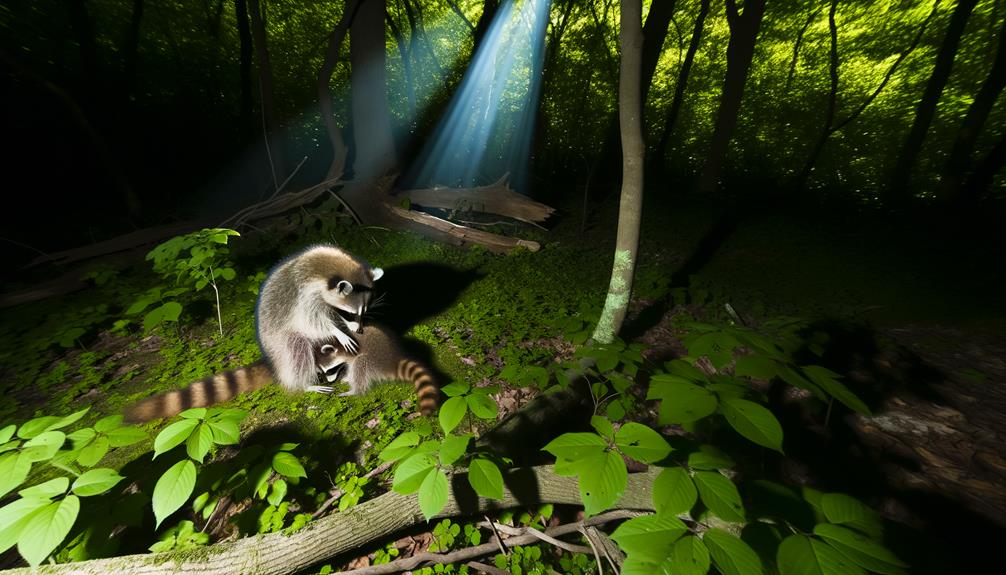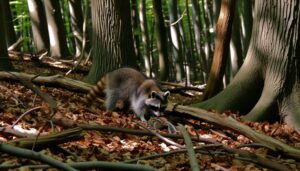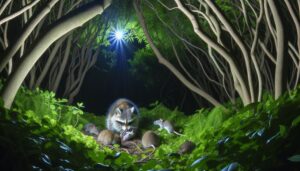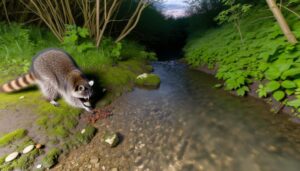Do Raccoons Eat Their Young?
Raccoons eating their offspring is an exceedingly rare occurrence, often associated with severe environmental stressors like habitat disturbance and limited food resources. Female raccoons usually exhibit significant care and maternal dedication, including grooming, feeding, and instructing crucial survival abilities to their young.
Infanticide, if witnessed, typically happens in extreme circumstances, underscoring the significance of steady habitats for successful reproduction. In contrast to certain misunderstandings, maternal conduct in raccoons underscores safeguarding and fostering.
Additional insight into raccoon environmental relationships provides a holistic view of their maternal behaviors and survival tactics.

Key Takeaways
- Infanticide in raccoons is rare and typically linked to extreme environmental stress or food scarcity.
- Maternal raccoons exhibit high levels of care, grooming, and protection towards their kits.
- Male raccoons are often misunderstood; most paternal interactions are non-lethal and not a significant threat.
- Raccoons have complex social behaviors; aggression towards offspring is uncommon under normal conditions.
- Conservation efforts aim to reduce environmental stressors that may contribute to rare infanticide events.
Raccoon Parental Behavior

Observing raccoon parental behavior reveals a complex and attentive approach to nurturing their offspring. Female raccoons, known as mothers or dams, demonstrate high levels of care and protection towards their kits.
Immediately post-birth, the mother maintains a close bond with her young, ensuring they remain warm and well-fed. She frequently grooms her kits, which not only keeps them clean but also reinforces social bonds.
As the kits grow, the mother teaches them essential survival skills, such as foraging and climbing. This period of maternal investment lasts several months, during which the mother remains vigilant against potential threats.
Such dedicated care underscores the importance of parental behavior in the development and survival of raccoon offspring.
Natural Survival Instincts
Driven by innate behaviors, raccoons exhibit a range of natural survival instincts that are crucial for their adaptation and resilience in diverse environments. These instincts include foraging strategies, nocturnal activity patterns, and acute problem-solving abilities.
Raccoons possess a highly developed sense of touch and dexterity, enabling them to manipulate objects and access food sources efficiently. Their omnivorous diet allows them to exploit a variety of food sources, ranging from insects to human refuse.
Additionally, raccoons demonstrate strong territorial behavior and use vocalizations and scent markings to communicate and establish boundaries. Such survival strategies are essential for maintaining their populations in both urban and natural habitats, ensuring their continued success as a species.
Environmental Stress Factors

Environmental stress factors such as habitat disruption and food scarcity can greatly influence the behavior of raccoons, including maternal actions towards their young.
Habitat disruption, often caused by urbanization and deforestation, may lead to increased competition for limited resources.
Additionally, food scarcity can worsen stress levels, potentially resulting in extreme behaviors such as infanticide or abandonment.
Habitat Disruption Impact
Habitat disruption greatly increases environmental stress factors that can negatively impact raccoon behavior, including instances of infanticide. Urbanization, deforestation, and pollution fragment raccoon habitats, leading to heightened competition for limited resources. This environmental stress can escalate aggression, anxiety, and abnormal behaviors, such as the consumption of their young.
Fragmented habitats also expose raccoons to increased risks from predators and human interactions, further intensifying stress levels. The lack of secure and stable nesting sites can drive female raccoons to abandon or harm their offspring. Scientific observations indicate that these disruptions contribute to a decline in raccoon welfare, highlighting the need for conservation efforts to mitigate the adverse effects of habitat loss and guarantee the species' ecological stability.
Food Scarcity Effects
The impact of habitat disruption is further compounded by food scarcity, which exacerbates environmental stress factors and can lead to infanticide among raccoon populations. Limited food availability forces raccoons into survival mode, where the weakest, often the young, are sacrificed to ensure the survival of the fittest. This phenomenon is driven by the need to conserve resources and increase the chances of long-term survival for the remaining population.
| Environmental Stress Factor | Effect on Raccoons |
|---|---|
| Habitat Disruption | Increased competition |
| Food Scarcity | Infanticide, malnutrition |
| Resource Competition | Social hierarchy shifts |
Understanding these dynamics is essential for wildlife conservation efforts, as mitigating food scarcity could reduce infanticidal behavior and improve the overall health of raccoon populations.
Dietary Habits and Needs
Raccoons are omnivorous mammals with a diverse diet that includes fruits, nuts, insects, and small vertebrates. Their nutritional requirements are met through a balance of protein, fats, and carbohydrates sourced from both plant and animal matter.
Understanding these dietary habits is essential for evaluating whether nutritional stress might influence any aberrant behaviors, such as cannibalism.
Omnivorous Dietary Preferences
Although raccoons are often perceived primarily as scavengers, their omnivorous dietary preferences encompass a wide range of both plant and animal matter, allowing them to adapt to diverse environments.
Scientifically classified as Procyon lotor, raccoons consume fruits, nuts, insects, small vertebrates, and even aquatic organisms like crayfish and amphibians. This dietary flexibility is pivotal for their survival in various habitats, from urban areas to forests.
Observational studies have documented raccoons foraging in human trash, agricultural fields, and natural water bodies. Their ability to exploit diverse food sources underscores their ecological versatility.
This omnivorous diet also influences their behavior, leading to complex foraging strategies and interactions within ecosystems. Understanding their dietary habits provides insight into their adaptive success.
Nutritional Requirements Explained
Meeting the nutritional requirements of raccoons involves a balance of macronutrients and micronutrients derived from their diverse diet, ensuring peak health and reproductive success. Raccoons are omnivorous, consuming a wide range of foods such as fruits, nuts, insects, small mammals, and aquatic organisms. This varied diet provides essential proteins, fats, carbohydrates, vitamins, and minerals necessary for their physiological functions.
Proteins support muscle development and repair, while fats serve as a dense energy source. Carbohydrates from fruits and grains offer immediate energy. Additionally, vitamins and minerals play critical roles in metabolic processes and immune function. Ensuring access to this broad spectrum of nutrients is crucial for the survival, growth, and reproductive viability of raccoon populations.
Observations and Case Studies

In examining the behavior of raccoons, field researchers have documented several instances that provide insight into their interactions with their offspring. Detailed observations reveal that raccoons exhibit complex social behaviors, particularly maternal care.
Case studies indicate that infanticide among raccoons is rare and typically linked to extreme conditions.
- Maternal Investment: Female raccoons demonstrate significant care, including grooming, feeding, and protecting their young.
- Environmental Stressors: Instances of infanticide are often correlated with severe environmental pressures such as food scarcity or habitat destruction.
- Social Hierarchies: Dominance hierarchies can influence maternal behavior, but aggression towards offspring is not a common trait.
These observations underscore the importance of context in interpreting raccoon behaviors related to their young.
Myths and Misconceptions
Despite the documented evidence of maternal investment and the rarity of infanticide, several myths and misconceptions about raccoons eating their young persist.
One common myth is that raccoons often kill and consume their offspring under stress or scarcity of resources. However, scientific observations indicate that infanticide is an exceptionally rare event in raccoon populations. When it does occur, it is usually linked to specific stressors such as extreme environmental conditions or severe malnutrition, rather than a common behavioral trait.
Another misconception is that male raccoons pose a significant threat to their offspring. While males may occasionally exhibit aggressive behavior, the majority of paternal interactions are non-lethal.
These myths are often perpetuated by anecdotal reports rather than empirical evidence.
Conclusion
To sum up, while raccoons display intricate parental behaviors and innate survival instincts, cases of infanticide are infrequent and usually influenced by environmental pressures and dietary requirements. Observations and case studies suggest that these events are not typical but rather uncommon, prompted by severe situations.
Misunderstandings persist, yet scientific proof highlights the flexibility and toughness of raccoons in changing habitats. Like a ship maneuvering through rough waters, raccoons modify their behaviors to secure the continuation of their species.






